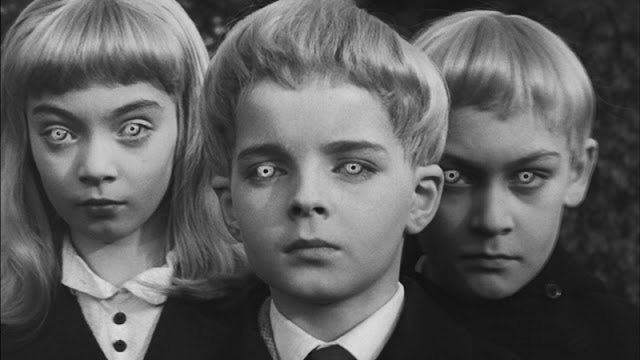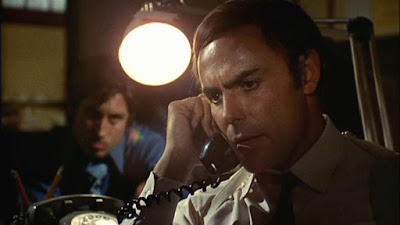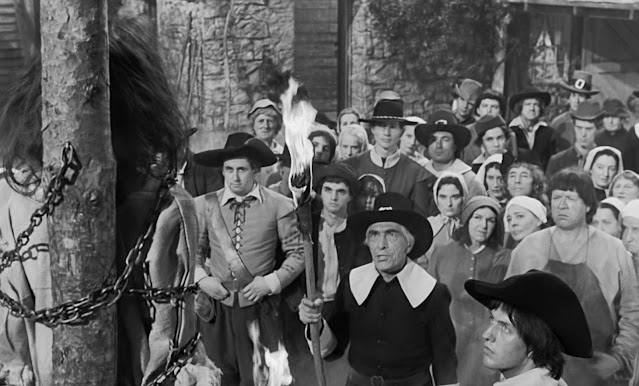Baby Blood (1990) When Yanka (Emmanuelle Escourrou) discovers she’s pregnant, she leaves her circus life and abusive boyfriend behind. Her troubles have only begun, however, when her body begins to undergo changes. Yanka moves from one abuser to another when the developing fetus begins speaking to her and controlling her actions. When it develops a taste for blood, she’s forced to kill on its behalf. Disturbing, gory and surprisingly funny, Director/co-writer Alain Robak’s Baby Blood takes a lot of chances. One thing’s for certain: you never quite know where it’s going from one moment to the next.
Rating: ***½. Available on Blu-ray and DVD
Beyond the Darkness (1979) Director Joe D’Amato’s tale of obsession and necrophilia, accompanied by a peppy Goblin soundtrack, horrifies and entrances, in equal measures. After his fiancée (Cinzia Monreale) suddenly dies, Frank (Kieran Canter) can’t bear to part with her. The amateur but skilled taxidermist digs her up and takes her home, much to the dismay of his housekeeper/former nanny Iris (Franca Stoppi), who has the hots for him. It’s all so messed up and in bad taste, but I couldn’t keep my eyes away. Needless to say, it won’t be everyone’s cup of tea, but if you’re in the mood for some truly demented horror, you’ve struck gold.
Rating: ***. Available on Blu-ray, DVD, Prime Video and
Tubi
The Strange World of Coffin Joe (1968) Everyone’s favorite maniacal, top-hatted undertaker (José Mojica Marins, who also directed and co-wrote the movie) introduces a trilogy of morbid tales for our speculation. In the first, (my favorite of the bunch), a dollmaker renowned for his creations, which feature lifelike eyes, deals with unwelcome intruders. In the second story, a pathetic balloon vendor takes his obsession with a young woman to unhealthy extremes. The final segment stars Marins as a sadistic doctor who uses a hapless couple as guinea pigs to prove his deranged theories about love.
Rating: ***. Available on Blu-ray and DVD
Curse of the Blue Lights (1988) No, it’s not about a haunted K-Mart, but a small-town legend concerning evil ghouls who want to immerse the world in darkness. A group of “teens” combat the ensuing zombie horde. Filmed in Pueblo, Colorado for probably less than the fee for Tom Cruise’s hair stylist, this nifty little fright flick from director/co-writer John Henry Johnson keeps things entertaining. There may not be anything particularly original about the plot, but there’s such an earnest quality to the production, and it looks like everyone had fun.
Rating: ***. Available on Blu-ray and DVD
The House that Would Not Die (1970) This low-key made-for-TV horror movie from director John Llewlyn Moxey (City of the Dead) plays a bit like an overlong segment of Night Gallery, with oodles of gothic atmosphere, but few scares. A young woman (Kitty Winn) and her aunt (Barbara Stanwyck) move into a Revolutionary War-era house that once belonged to a prominent general. Strange things start going bump in the night, as the house’s secrets are gradually revealed. It’s a little too languidly paced for its own good, but it has its moments.
Rating ***. Available on Blu-ray, DVD and Tubi
No Tears for the Damned (aka: The Las Vegas Strangler) (1968) In this sleazy little proto-slasher, a brow-beaten mama’s boy Jeff Murray (Robert Dix) roams the Las Vegas strip, preying on unsuspecting dancers and sex workers. In an impulsive moment, he marries a naïve hooker (Gillian Simpson), only to leave her at home with his disapproving mother (June Drake). The acting is strictly B-grade, and the murders are unconvincing, but the flick has its weird charms, including some choice dialogue (“He’s as queer as a three-dollar bill.”; or when the protagonist hears that her new husband has been hanging around with a gay piano player: “Guess I’ve been reading the wrong kind of fairy tales.”). Yeah, it’s anything but subtle.
Rating: **½. Available on Blu-ray (included in the Vinegar
Syndrome’s Lost Picture Show box set) and Tubi
Auntie Lee’s Meat Pies (1992) Karen Black stars as the title character, who runs a booming meat pie business (three guesses what’s in them, and the first two don’t count). Her four lascivious young nieces lure stupid, horny men home to their doom. They’re assisted by Auntie Lee’s childlike brother Larry (Michael Berryman, who seems to be channeling Lenny from Of Mice and Men). Pat Morita also appears as the inept local sheriff, who seems to have a uncanny knack for ignoring the obvious. There are worse ways to spend 100 minutes.
Fun Fact: Besides sharing a similar theme to Motel Hell (1980) one of the primary filming locations was the Sable Ranch, used in both productions.
Rating: **½. Available on Blu-ray and Kanopy
The Boogey Man (1980) In the opening scene, a young girl witnesses her brother stab their mother’s abusive boyfriend to death. Flash forward 20 years. While Lacey (Suzanna Love, who also co-wrote the screenplay) tries to live a reasonably mundane life as a wife and mother, her brother Willy (played by Love’s real-life brother, Nicholas), left mute by the traumatic event, still harbors repressed anger. Haunted by nightmares about the incident, she revisits her childhood home with her husband Jake (Ron James). She encounters a mirror that has an evil presence trapped within and shatters it. Inexplicably, she brings it home to reassemble the pieces. Strange deaths begin to occur. Working with the help of her therapist (played by an emaciated John Carradine), Lacey confronts her childhood fears, while contending with an annoying husband who thinks she’s imagining everything. The Boogey Man benefits from some unintentional humor but it’s otherwise standard fare.
Rating: **½. Available on Blu-ray, DVD, Kanopy and
Tubi
Rating: *½. Available on Blu-ray and DVD
Spookies (1986) They don’t make ‘em like they used to, and that’s not always a bad thing. A group of friends (who seem to hate each other) arrive at a secluded mansion to party the night away. They’re trapped by a malevolent sorcerer who wants to revive his dead wife. The subsequent 80+ minutes consist of the clueless companions running around aimlessly, shouting at each other, and screaming incessantly. Credited to three (!) directors, Spookies features some cool low-budget practical effects but suffers from an incoherent plot and unlikeable characters. There are much better low-budget choices for your late-night horror viewing.
Rating: *½. Available on Blu-ray, DVD and Tubi













































